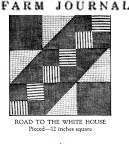Washington Whirlwind #5:
Road to the White House by Jeanne Arnieri
After Abraham Lincoln was elected the family closed their Illinois house and made plans to travel to Washington in the spring of 1861. Their
Road to the White House was complicated by hate-filled rhetoric from Southern "Fire-Eaters" threatening to kill the president-elect on his trip east. Several body guards and Pinkerton's detectives accompanied the Lincolns on the train ride as did a few young men whom Lincoln had befriended in his legal and political life. Three close friends were on the train.
1863 Alexander Gardner Photograph
John Nicolay & John Hay were Illinois newspapermen
appointed Lincoln's secretaries. Moustaches and beards
became the fashion in the early 1860s and Lincoln showed
up in Washington with a new beard.
"To Gardner's Gallery & were soon joined by Nico and the Prest . ... Nico & I immortalized ourselves by having ourselves done in a group with the Prest." John Hay, November, 1863.
Ephraim Elmer Ellsworth 1837-1861
Also in the entourage was New Yorker Elmer Ellsworth, about 24, who'd been studying law with Lincoln in Springfield. Ellsworth was a charismatic character who'd created a military drill team in Chicago. Appointed (self-appointed?) a Colonel, he popularized the Zouave uniform developed by African/French troops, consisting of a fez, baggy trousers and a good deal of
soutache or flat braid trim.
Ellsworth's Zouave Drill Book, published
in 1861.
New York Zouaves
When the war began Ellsworth established the 11th New York Fire Zouaves.
Medhurst & Company
17-year-old James Rockwell of Duryéa's Zouaves in the distinctive outfit.
The Zouave jacket became female fashion.
Detail of a wool Zouave quilt in the Museum of Fine Arts/Boston collection
Road to the White House by Becky Brown
During the spring of 1861 as Virginians argued secession, hotel keeper James W. Jackson flew a large Confederate flag from atop Alexandria's Marshall House, so large it was visible from the White House. John Hay recorded an April 29th visit to Nicolay's bedroom from Kansas Senator James Lane who "was at the window filling his soul with gall by steady telescopic contemplating of a Secession flag impudently flaunting over a roof in Alexandria." Lane suggested the flag be shot away.
James William Jackson (1823-1861) of Virginia
Ellsworth, a frequent White House guest and a "great pet in the family," was also angered by the Secessionist taunt from across the Potomac.
May 24th, the day after Virginians voted to secede, Union troops occupied Alexandria, which was too close to the Union capitol to let it slip into the Confederacy.
Alexandria
Elmer Ellsworth was among the occupiers who encountered little resistance. Feeling cocky he decided to take the Marshall House flag with backup from a few fellow soldiers. As he descended the stairs with the trophy in his hands, James Jackson shot and killed him. A fellow Zouave killed Jackson. This confrontation resulting in mutual destruction so early in the war became a rallying point for both Union and Confederates and a metaphor for what was to come.
Jackson left a wife and children. Ellsworth left his parents in New York and a bereft Lincoln family.
The Harper's Weekly image became a propaganda icon....
Library of Congress
Ellsworth was given a memorial service at the White House with the Lincolns in tears. Julia Taft remembered that she with the Taft and Lincoln boys had visited Ellsworth to watch the Zouaves drill just the day before his death:
"I felt an impulse to tell the President about our pleasant visit to Colonel Ellsworth the day before he was ordered to Alexandria but I was told that the President wept at the mention of Ellsworth and I was afraid it would make him grieve.”
Road to the White House by Denniele Bohannon
The Block
This block composed of triangles and four-patches was popular in many shading arrangements.
Made by Cora Myrtle Graham Boatwright, documented by the Arizona Project.
I was out of town last week so did not get Elsie Ridgley's two versions
up here.























No comments:
Post a Comment